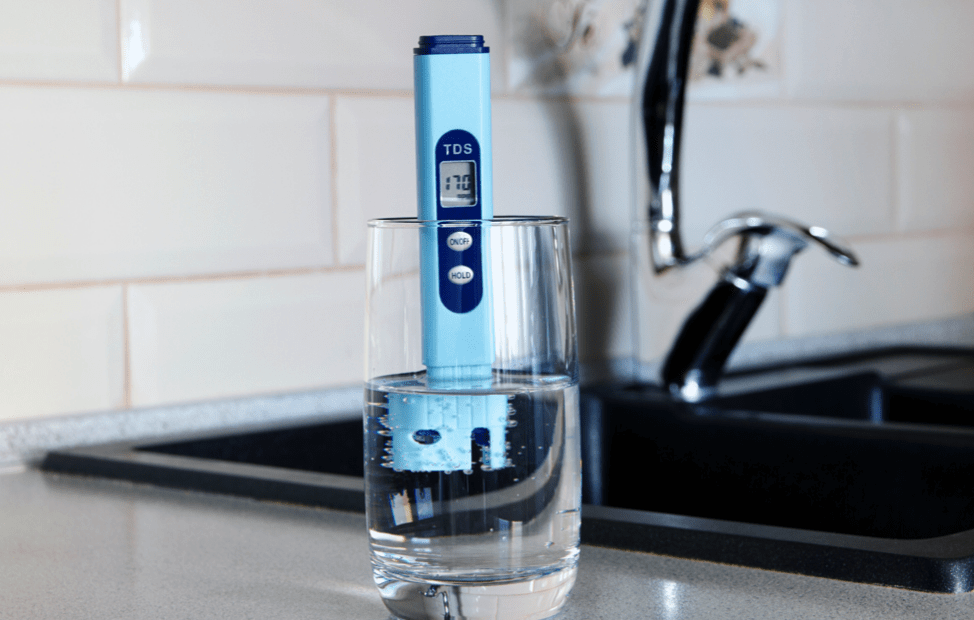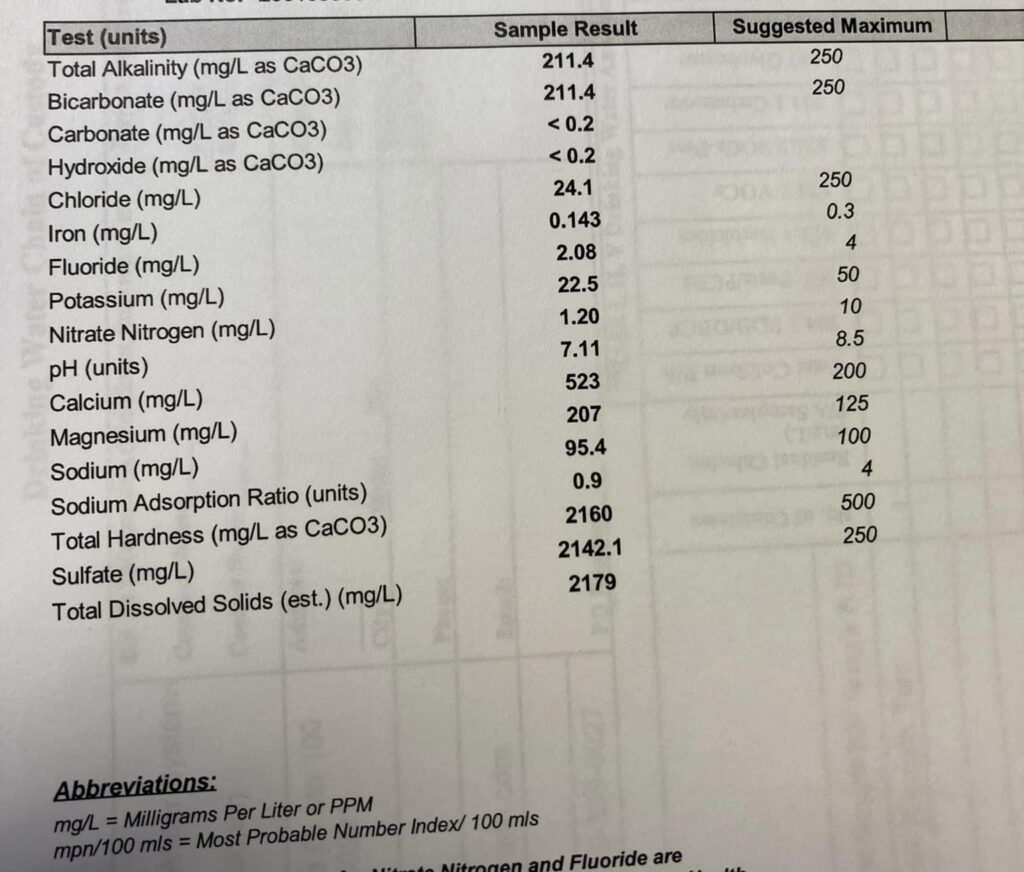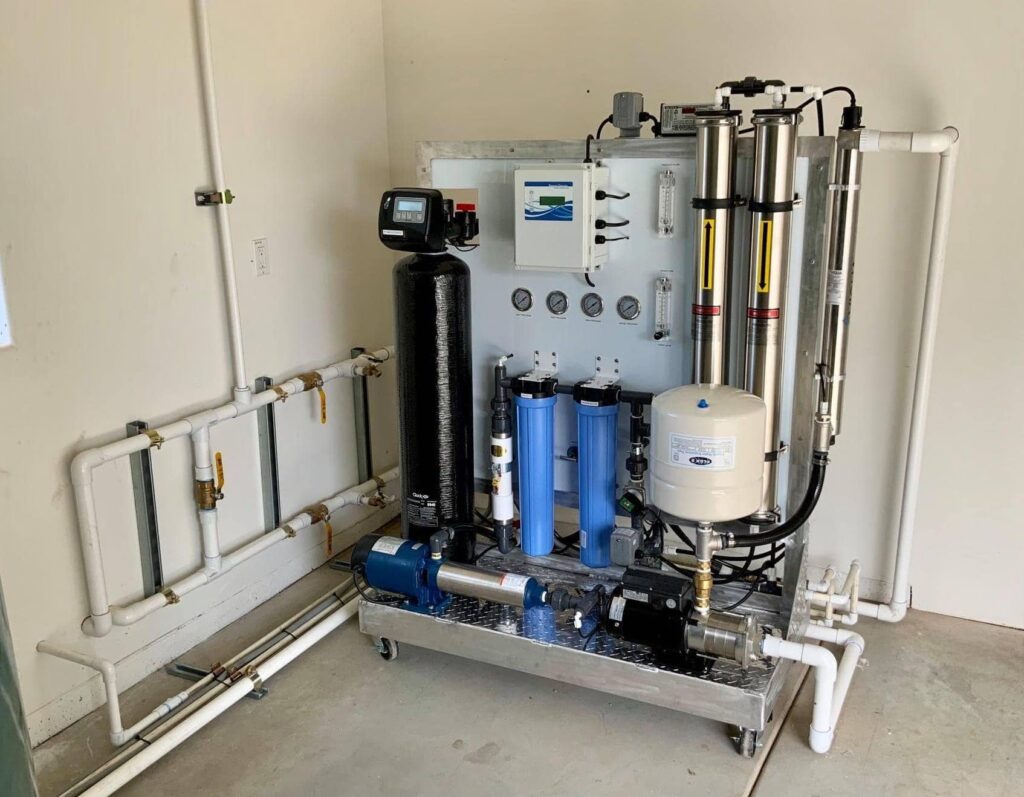Total dissolved solids, also known as “TDS” serves as a key indicator of your home’s water quality, regardless of whether your water comes from a private well or a municipal supply.
In this article, we will discuss the total dissolved solids (TDS) in water and why its measurement is important. You will gain insights into how high TDS levels directly impacts the taste and odor of water, the condition of home’s plumbing system, potential health effects, and even everyday tasks like cooking and cleaning.
Finally, we will delve into the realm of the most effective water filtration methods for TDS reduction, providing you with the luxury of crystal-clear, pristine water perfectly suited to meet your household needs.
What is TDS in Water?
Total dissolved solids (TDS) is the concentration of both organic and inorganic substances, such as minerals, salts, metals, and ions, dissolved in the water. Simply put, TDS is a measurement of all the non-volatile dissolved solids present in water that are not H₂O molecules. TDS is typically measured in milligrams per liter (mg/L) or parts per million (ppm). To clarify, 1 mg/L is roughly equivalent to 1 ppm.
It’s important to note that TDS reading doesn’t account for dissolved gases like nitrogen, oxygen, and carbon dioxide, which are commonly present in groundwater and the atmosphere. These gases can significantly affect the taste, odor, and overall quality of water, but they are not reflected in the TDS reading.
The U.S. Environmental Protection Agency (EPA) labels TDS as a secondary drinking water contaminant. Means, it typically doesn’t pose direct health risks but it can lead to cosmetic, aesthetic, and technical issues. For example, water with elevated iron and manganese levels isn’t harmful, but it can cause unsightly stains on fixtures and laundry, as well as water discoloration. Similarly, hydrogen sulfide gas dissolved in water won’t make you sick, but its notorious “rotten egg” odor can be off-putting and impact the taste of water and beverages prepared with it.
What Does TDS Consist of?
Total dissolved solids (TDS) mainly consist of calcium, magnesium, sodium, potassium, hydrogen carbonate, chlorides, sulfates, and nitrate anions, as per the World Health Organization (WHO). Moreover, the presence of various other contaminants, such as zinc, aluminum, copper, arsenic, iron, lead, chlorine, pesticides, and herbicides, can also be encountered.
What are the Sources of Total Dissolved Solids?
Total dissolved solids (TDS) can be absorbed by water from various sources such as rocks, pipes, agricultural runoff, urban runoff, road salts, pesticides, herbicides, and sediment in well water.
Why Should You Measure the TDS Level of Water?
You should measure the TDS levels in the water because it provides a general understanding of the overall composition of water quality and helps in choosing the most effective filtration system for your home.
For instance, a low TDS reading of 100 mg/L (100 ppm), indicates that water is low on organic and inorganic substances and lacks high mineral content. On the other hand, if water displays a high TDS reading, such as 1500 mg/L (1500 ppm), it mostly likely suggests an abundance of potentially undesirable contaminants, minerals, and salts, leading to issues like plumbing corrosion and scaling on appliances. It also results in a salty or bitter taste, making it less appealing for consumption and cooking.
How to Test for TDS in Water
Using a TDS meter is the fastest and simplest way to test for total dissolved solids in water. A TDS meter is a handheld device that operates on the principle of electrical conductivity. It uses a conductive probe, typically made of stainless steel or platinum, that makes contact with the water. The TDS meter’s battery generates a small electric current that passes through the dissolved ions, carrying an electric charge, and consequently increasing electrical conductivity. The TDS meter then displays the reading on a digital or analog screen.
A TDS meter measures the concentration of dissolved substances in water and provides a value in parts per million (ppm). For instance, if your TDS reading shows 100 ppm, it means that out of every million water molecules, 100 are dissolved solids, while the remaining 999,900 are water molecules.

It’s important to understand that TDS meters can’t determine whether your water is safe to drink, as they don’t identify the specific types of dissolved solids such as organic and inorganic substances, minerals, salts, metals, and ions present in water. However, TDS meters can be a useful tool to confirm any suspicions you may have about your water quality if you notice limescale build-up or a change in the taste or odor of your water.
To reveal the exact concentration of dissolved solids and overall water quality, it’s recommended to get your water tested by a certified laboratory. If you are on city water, the public water supplier is obligated by law to furnish you with a comprehensive report detailing the contents of your water supply.

TDS readings aren’t always a negative presence in the water. A moderate TDS level, typically ranging from 100 to 300 mg/L (100 to 300 ppm), often indicates that the water contains beneficial minerals. However, a TDS level exceeding 500 ppm can be a sign of harmful dissolved impurities, which can lead to scaling in water pipes and in water-based appliances like dishwashers, washing machines, water heaters, steam irons, and coffee makers in your home.
For drinking water, the EPA recommends TDS levels to be below 500 mg/L (500 ppm). According to the World Health Organization (WHO), TDS levels are considered excellent if they are below 300 mg/L (300 ppm) and good if they fall between 300 and 600 mg/L (300 and 600 ppm). However, TDS levels between 900 and 1200 mg/L (900 and 1200 ppm) are considered poor, and levels exceeding 1200 mg/L (1200 ppm) are considered unacceptable.
For insights on how various TDS levels impact water taste, appearance, plumbing, and overall health and well-being, see the table below.
| TDS Level (mg/L or ppm) | Taste | Appearance | Plumbing | Health/Well-being |
|---|---|---|---|---|
| Less than 50 | Tastes flat and lacks flavor | Clear and transparent | No significant impact on plumbing | Not necessarily beneficial, but not harmful either |
| 50-100 | Tastes slightly salty | Clear and sparkling | Minimal scaling in plumbing fixtures | May be slightly beneficial due to the presence of essential minerals |
| 100-250 | Tastes refreshing and pleasant | Clear and sparkling | Minimal scaling in plumbing fixtures | Slightly beneficial due to the presence of essential minerals |
| 300-500 | Tastes slightly salty | May be Slightly cloudy | Slight scaling, minimal impact on pipes | Beneficial for drinking as it likely contains healthy minerals |
| 600-900 | Tastes bitter and unpleasant | Cloudy and turbid | Moderate scaling and potential corrosion | May lead to digestive discomfort in some individuals |
| 900-1200 | Tastes very bitter and unpalatable | Very murky | Severe scaling, increased risk of corrosion | Possible health risks such as mineral imbalances |
| More than 1200 | Tastes extremely bitter | Very murky and may have sediment | Very severe scaling, high risk of corrosion | Potential health hazards including kidney and heart issues |
What are the Potential Risks of High TDS in Water?
There are five potential risks of high total dissolved solids (TDS) in water:
- Taste and smell: Water with high TDS levels tends to have a salty, bitter, or metallic taste and an unpleasant odor like “sulfur” or “rotten eggs.” It also appears cloudy or murky.
- Plumbing and appliances: Water with high TDS levels (typically above 300 mg/L or ppm), mainly caused by elevated levels of calcium and magnesium, leads to the formation of limescale in plumbing pipes and increased wear and tear on water-based appliances such as water heaters, washing machines, kettles, and coffee makers. This can result in costly plumbing repairs and replacements, increased use of cleaning agents and detergents, and a reduced lifespan of plumbing pipes and appliances.
- Health: While high TDS levels generally don’t pose an immediate health risk, if the TDS reading exceeds the EPA’s guideline of 500 mg/L, it requires further investigation for toxic chemicals and heavy metals. When TDS levels exceed 1000 mg/L, the water becomes unsafe for consumption. This is because high TDS water often contains contaminants such as arsenic, lead, and copper, which can be serious health concerns. Consuming water with high levels of arsenic over time can increase the risk of diabetes, bladder cancer, lung cancer, and liver issues, according to the Minnesota Department of Health. Water containing lead can be particularly harmful to children, leading to permanent brain and nervous system damage, as well as an increased risk of high blood pressure and kidney damage in adults, as stated by the World Health Organization (WHO). Additionally, exposure to high doses of copper can cause gastrointestinal distress in the short term, and long-term exposure can result in anemia and impaired kidney and liver function, according to the Washington State Department of Health.
- Cleaning-related activities: Water with high TDS levels, typically more than 150 – 200 mg/L (150 – 200 ppm), containing elevated amounts of calcium, magnesium, and sulfates, causes issues during washing and cleaning activities. When used for laundry, it leaves mineral deposits on clothes, resulting in discoloration and stains. Similarly, when cleaning surfaces like countertops, sinks, glassware, and dishes, the water’s mineral content can leave unsightly spots and a cloudy film behind, making it challenging to achieve a sparkling clean finish.
- Cooking: Cooking with water that has high TDS levels, typically more than 150 – 200 mg/L (150 – 200 ppm), specifically containing calcium, magnesium, and chlorine, can negatively impact the taste and smell of both food and beverages. The presence of calcium and magnesium makes the water hard, causing issues when cooking pasta and rice, as it may react with the starch and result in a salty taste. Additionally, excessive chlorine can impart an unpleasant and slightly off-putting flavor to cooked dishes like steamed vegetables, as well as beverages such as brewed tea and coffee prepared with water.
How to Reduce High TDS Levels in Water
To reduce TDS levels in water, filtration systems like reverse osmosis, water distillers, and deionizers are excellent options.
Reverse Osmosis Systems
Reverse Osmosis (RO) systems are most efficient in reducing total dissolved solids (TDS) to 25 mg/L (25 ppm) or lower and impurities. The systems use a semi-permeable membrane with extremely tiny pores, typically ranging from 0.0001 to 0.001 microns in size. When unfiltered water is pressurized and forced through the RO membrane, these minute pores act as a highly efficient barrier, effectively blocking larger molecules such as dissolved salts, minerals, metals, and various contaminants. Meanwhile, only water molecules (H₂O) are allowed to pass through the membrane, resulting in crystal-clear water.
The Whole House RO systems are an excellent choice to tackle high TDS levels, even above 1000 mg/L (1000 ppm). This comprehensive system guarantees that every drop of water used for showers, faucets, drinking, cooking, and laundry is free from contaminants, hardness, and unpleasant odors. However, consider the system’s downsides, including the need for more space and upfront costs ranging from $4800 to $14,000 on average. Additionally, regular maintenance of the filtration system, RO membranes, and post-filtration components is vital for peak performance and can cost an extra $1,750-$7,250 per year.

On the other hand, if you’re aiming for targeted TDS reduction, consider point-of-use (POU) RO systems. They are space-efficient and budget-friendly options compared to the Whole House RO systems. With the POU systems, you can invest in purifying the water specifically at the point where you need it most, like in the kitchen or near drinking water faucets. The cost of point-of-use RO systems ranges from $150 to $1,800, and their maintenance is simpler, with fewer filter replacements, which can cost around $65 to $315 per year.
Water Distillers
Water distillers are highly effective in reducing TDS levels to under 10 mg/L (10 ppm). The process involves boiling water in one chamber until it evaporates and then condensing the steam in a second chamber. During this process, TDS contaminants with higher boiling points than water (100°C or 212°F) are left behind in the first chamber and subsequently flushed out.
After distillation, the water typically goes through a carbon filter stage to trap any contaminants that might have evaporated and condensed along with the water. As a result, the water obtained has a very low TDS content, often ranging from 1 to 10 mg/L (1 to 10 ppm). However, it’s recommended to remineralize the water to achieve a balanced and refreshing flavor.
Despite its reliability in reducing TDS, distillation is a slow process, taking around 4-6 hours to produce one gallon (3.78541 liters or 16 cups) of water. That’s why water distillers are best suited for point-of-use applications, providing purified water for drinking and cooking, rather than supplying water for the entire household.
Prices for home water distillers typically range from $250 to roughly $650, with additional yearly costs of around $20 to $50 for carbon filter replacements.
Deionization
Deionization systems use an ion-exchange process to reduce TDS levels to under 10 mg/L (10 ppm) by removing charged dissolved solids. In this process, positively charged ions (cations) like calcium (Ca²⁺) and magnesium (Mg²⁺) are replaced with hydrogen ions (H⁺), and negatively charged ions (anions) such as chloride (Cl⁻) and sulfate (SO₄²⁻) are replaced with hydroxyl ions (OH⁻), effectively exchanging the contaminants with the essential components of water, leaving you with impressively pure water.
It’s important to note that deionization only targets charged particles, leaving non-ionized contaminants like metals (lead, mercury, and arsenic) and microorganisms (bacteria, viruses, and algae) unaffected. To enhance effectiveness and extend the system’s lifespan, deionization is often preceded by a Reverse Osmosis filter, which removes these non-ionized contaminants before the deionization stage.
Deionization systems are ideal for point-of-use applications, providing highly pure water for drinking and cooking. However, they are not well-suited for whole-house use due to their selective nature and inability to remove non-ionized contaminants. Moreover, deionization systems are typically 1.5 to 4 times more expensive than other water purification systems like reverse osmosis.
Deionization systems require regular flushing and resin replacement, adding to the cost of ownership and maintenance. The cost of deionization systems typically ranges from $300 to $800, with resin replacement expenses amounting to $200-$500 every 2-3 years, plus around $100-$200 per year for cleaning.
Total Dissolved Solids FAQs
Here are your TDS questions answered:
Does a High TDS Mean Hard Water?
No, a high TDS reading doesn’t necessarily mean you have hard water. While hard water can have high TDS levels due to its elevated calcium and magnesium content, other dissolved solids like organic and inorganic substances and heavy metals can also contribute to a high TDS reading. It’s important to consider the specific composition of the dissolved solids to determine whether the water is hard or if there are other factors like pH and temperature contributing to the TDS level.
What is the Safe TDS Level of Water for Drinking?
The safe TDS level of water for drinking is less than 600 mg/L (600 ppm), according to the World Health Organization (WHO). The upper limit for TDS in drinking water is 500 mg/L (500 ppm), as stated by the U.S. Environmental Protection Agency (EPA).
Can TDS Be Reduced By Boiling Water?
No, boiling water doesn’t reduce the level of total dissolved solids (TDS). Boiling water simply turns it into steam, leaving the total dissolved solids (TDS) behind as deposits. These dissolved solids, such as minerals and salts, remain largely unchanged in concentration during the boiling process. The residues left behind after boiling are essentially the same TDS present in the original water, just more concentrated.
Can You Reduce TDS in Water Without RO?
Yes, total dissolved solids (TDS) can be reduced without using reverse osmosis (RO). Two effective methods for TDS reduction are distillation and deionization, which can effectively reduce TDS levels to 10 mg/L (10 ppm) or below.
Can a Water Softener Reduce TDS?
No, a water softener can’t reduce the total dissolved solids (TDS). While a water softener process replaces certain hardness minerals like calcium (Ca²⁺) and magnesium (Mg²⁺) with sodium ions (Na⁺) through an ion exchange process, it doesn’t reduce the overall quantity of TDS in the water.